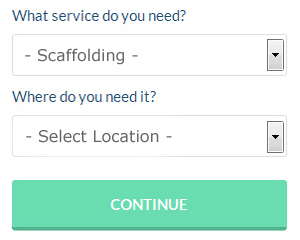Scaffolding and Scaffolders: When undertaking significant construction work on your home or business in the UK, such as chimney stack restoration, brickwork repointing, roof installation, or window updates, it is highly likely that scaffolding will be required to ensure the safety of both occupants and builders. In such instances, it is imperative to engage a reliable scaffolder in the UK who can provide a proper quote and ensure the correct installation of the necessary scaffolding. Cutting corners in this matter is not advisable, as proper scaffolding is crucial for safety. Always opt for a reputable scaffolder, regardless of the associated cost, and avoid unscrupulous operators or contractors.
Scaffolding - An Overview: Scaffolding serves as a vital system that enables workers to carry out tasks safely and access elevated areas that would otherwise be difficult to reach on residential, commercial, and other structures. It consists of a sturdy framework comprising vertical tubes and connectors, which, when securely fastened, create a stable and secure working platform. Apart from providing a safe working environment, scaffolding also plays a crucial role in safeguarding both building occupants and the general public by preventing falling debris and dust during construction activities. The nature of the construction work being undertaken determines whether a scaffold is necessary, as Health and Safety regulations may require a comprehensive risk assessment to assess the need for scaffolding. This assessment ensures that the appropriate safety measures are in place to mitigate any potential risks associated with working at height.
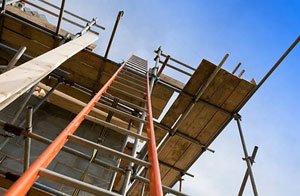
The construction of a scaffold comprises various components that are assembled to create a stable and secure structure by skilled scaffolders. These components include swivel clamps, which allow for flexible connections; right angle clamps and facade braces for structural support; base plates and ledgers that form the foundation and horizontal connections; ladders and putlogs for access and support; and scaffold boards for the working platform. Additionally, safety features such as guard rails, toeboards, and board clamps are essential to protect workers from falls. Couplers are used to join different elements securely, while sole boards and sills distribute weight evenly to prevent sinking. Midrails, standards, and spade ends contribute further to the scaffold's stability. For securing ladders and enhancing rigidity, limpet clamps, ladder clamps, and diagonal braces are integral. Each of these components plays a critical role in ensuring the scaffold's functionality and safety, making it a vital tool for construction and maintenance work.
Scaffolding comes in various forms, each designed for specific purposes. Among the many types available are shoring scaffolds, scaffold towers, double scaffolds (masons scaffolding), confined space scaffolds, rolling scaffolds, tube and fitting scaffolding, suspended scaffolding, single scaffolds, trestle scaffolding, cantilever scaffolding, and patented scaffolding. For residential properties in the UK, the most common type used is the single or bricklayer's scaffold. However, any of the aforementioned styles might be necessary for construction work carried out on business premises or commercial buildings. The choice of scaffold type depends on the specific requirements and nature of the project.
When it comes to scaffolding for your project, it is advisable to seek out an experienced scaffolder who has received approval from the local authority. Prior to use, the scaffolding must undergo safety checks, which should be conducted before the initial use, regularly every 7 days, after adverse weather conditions, and following any modifications or alterations. If the scaffolding will encroach on a pavement or highway, obtaining special permission from the local council is necessary. Such permissions are required for various structures, including stagings, pedestrian barriers, hoarding, scaffolding, access towers, and the placement of contractor's equipment or waste skips. If the scaffolding is positioned on a public highway, it must be equipped with safety lighting, which will be provided by the scaffolders in the UK. Additionally, scaffolding in the UK must comply with the European Standard BS EN 12811-1, which ensures that the scaffolding meets the required structural design specifications for working and access scaffolds.
You may already be acquainted with a couple of local scaffolding companies in your area. Scaffolders are known for strategically placing eye-catching promotional hoardings on their scaffolds, effectively raising brand awareness across the UK region. Having multiple options to choose from is a favourable position to be in. To add more to your shortlist you could also submit a quote form to Bark.com, who'll save you loads of time and money by getting in touch with local scaffolding businesses for you. You will shortly have enough potential scaffolders in order to make a well informed choice for your upcoming project.
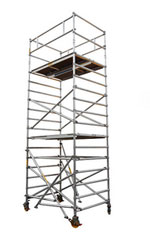
Scaffold Tower Hire UK - If your building project is relatively small in scale, a scaffold tower could be a suitable solution, offering increased flexibility. Tower scaffolds can be hired from various sources, including tool hire companies, builders merchants, and even scaffolding companies themselves. Established companies such as HSS, Hire Station, Jewson, Travis and Perkins, as well as local tool hire firms, are worth considering for scaffold tower rentals.
Scaffold towers are typically constructed using lightweight alloy materials, making them easy to transport and manoeuvre on-site. They are available in various sizes and configurations to accommodate different project requirements. Whether you need a scaffold tower for a specific task, you have a range of options to choose from. These include single width scaffold towers, cantilever towers, guard rail towers, non-conductive (fibreglass) towers, podium steps, folding low-level platforms, tower bridge decks, double width alloy towers, span access platforms, stairwell access towers, single-person towers, microfold towers, folding indoor scaffold towers, and other customized work assisting towers. Depending on the scope of work on your property, it may even be more cost-effective to purchase a basic scaffold tower rather than repeatedly hiring one.
The Need for Scaffolding
Scaffolding is essential for a wide range of construction projects, regardless of the size or type of building involved. Whether it's an industrial, residential, or public structure, scaffolding is required during demolition, construction, or significant repairs. In the case of tall buildings like skyscrapers, scaffolding is erected from the ground up and gradually dismantled from the top as the building decreases in height. Scaffolds are available to meet various requirements and can be utilised for almost any imaginable purpose.
UK Temporary Roofing Scaffolds
Temporary roofing scaffolding is a commonly utilised type of scaffolding, often observed on houses throughout the UK. It serves the purpose of safeguarding the interior of a property from inclement weather during extensive roof work. While temporary roof scaffolding is commonly employed in residential settings, commercial buildings and office blocks can also benefit from this system. Such scaffolding can be integrated into an existing scaffold installation or erected as a separate structure when additional scaffolding is unnecessary. In some cases, they can even be designed to be mobile, allowing for relocation as the project progresses. Temporary roofs are particularly well-suited for projects such as loft conversions, re-roofing, new builds, and properties that have been damaged by fire. (Tags: Temporary Roof, Temporary Roofing UK, Temporary Roof Scaffolds UK)
The Various Types of Scaffolding
- Confined Space Scaffolds
- Patented Scaffolding
- Cantilever Scaffolds
- Tube and Fitting Scaffolding
- Scaffold Towers
- Single Scaffolds (Bricklayers Scaffolding)
- Double Scaffolds
- Rolling Scaffolds
- Suspended Scaffolds
- Trestle Scaffolding
- Shoring Scaffolds
Tube & Fitting Scaffolds UK
The most commonly used scaffolding type in the UK is referred to as "tube & fitting" scaffolding, and it is widely prevalent across the country. This type of scaffolding involves joining various lengths of aluminium or galvanized steel tubing together using a range of couplers, clamps, and clips, creating a robust framework. Tube and fitting scaffolding can be customised and assembled in numerous configurations and designs to meet the specific requirements of construction sites throughout the UK. Safety measures can be incorporated into tube and fitting scaffolds to comply with Work at Height Regulations, such as the addition of brick guards, toe boards, fans, and rubble netting, which help prevent falling objects and provide enhanced safety.
The Primary Elements of a Scaffold
- Base Plates
- Standards
- Putlogs
- Ledgers
- Scaffold Boards
- Diagonal Braces
- Midrails
- Base Jack
- Toeboards
- Guard Rails
Work at Height Regulations
In the United Kingdom, scaffolding erected on construction sites must comply with the Working at Height Regulations, which were introduced in 2005. These regulations were implemented due to the alarming statistics regarding falls from height, with 46 reported deaths and 3350 significant injuries recorded in Britain during the 2005/2006 period. The Work at Height Regulations (2005) cover any work activity or workplace where there is a risk of falling from a height that could result in serious injury. Furthermore, there are provisions in place to control the potential harm caused by falling debris and objects to passers-by, bystanders, and ground-level workers.
It is the duty of the responsible party, known as the duty-holder, to ensure that all scaffolding and equipment are secure, and that every necessary safety precaution is implemented to mitigate the risk of harm. This responsibility includes taking appropriate measures to prevent falls, secure scaffolding structures, and maintain safety for workers and the public. Compliance with these regulations is essential to promote a safe working environment and prevent accidents and injuries caused by falls from height.
Scaffolding Weather Protection
Scaffolding weather protection is essential for construction projects, ensuring the safety of workers and the integrity of the structure. In harsh weather conditions, such as rain, snow, or extreme heat, scaffolding serves as a protective shield.
Rain and snow can cause slippery surfaces, increasing the risk of accidents. Weather protection, like tarps or enclosures, shields workers and materials from these elements. Extreme heat can also pose health hazards, but proper shading and ventilation through weather protection measures can mitigate these risks.
Moreover, weather protection prevents moisture from seeping into the construction materials, reducing the likelihood of structural damage and prolonging the life of the building. It also allows work to continue uninterrupted, saving time and money.
In summary, scaffolding weather protection is not just a convenience; it's a crucial safety and efficiency measure in construction, ensuring that projects progress smoothly and safely regardless of the weather conditions
Cuplock Scaffolding
Cuplock scaffolding is a versatile and widely used system in the construction industry, known for its efficiency, durability, and ease of assembly. This innovative scaffolding system relies on a unique design featuring horizontal and vertical standards with cup-like connectors, which allow for quick and secure connections without the need for nuts and bolts.
One of the primary advantages of cuplock scaffolding is its speed of installation. The system is designed for rapid assembly, reducing downtime on construction sites and increasing overall productivity. Its modular nature makes it adaptable to various shapes and sizes, accommodating complex building structures with ease.
Furthermore, cuplock scaffolding is renowned for its stability and load-bearing capacity. The interlocking cups provide a robust connection that can support heavy loads, ensuring the safety of workers and materials at elevated heights. This system also offers a high degree of flexibility, allowing for adjustments in height and configuration as the project progresses.
In addition to its strength and flexibility, cuplock scaffolding is known for its durability and resistance to corrosion, thanks to its galvanized steel construction. This longevity makes it a cost-effective choice for long-term construction projects.
In summary, cuplock scaffolding is a popular choice in the construction industry due to its speed of assembly, stability, versatility, and durability. Its innovative design and modular components make it a reliable and efficient solution for a wide range of construction needs.
Scaffold Signage
Scaffold signage plays a crucial role in ensuring safety, communication, and compliance on construction sites where scaffolding is present. These signs are strategically placed to convey essential information to workers, visitors, and the public. They typically include warnings about potential hazards, safety procedures, and contact details for the scaffold contractor.
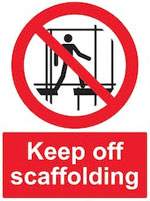
One of the primary purposes of scaffold signage is to alert individuals to potential dangers associated with the scaffolding structure. This includes warnings about falling objects, restricted access zones, and height-related risks. Clear and concise signage can significantly reduce the likelihood of accidents and injuries on the site.
In addition to safety messages, scaffold signage often includes identification details, such as the name of the scaffolding company, permit numbers, and inspection dates. This information ensures compliance with local regulations and allows authorities to verify the legitimacy of the scaffold.
Overall, scaffold signage is a vital tool in maintaining a safe and organized construction environment, promoting adherence to regulations, and preventing accidents
Do I Need Permission To Put Up Scaffolding?
In most cases, you will need permission to put up scaffolding, especially if it encroaches on public property or affects neighboring properties. The specific requirements for obtaining permission can vary depending on your location and the regulations set by the local council or relevant authorities.
Here are some key considerations regarding permission for putting up scaffolding:
- Local Council Approval: Contact your local council or planning department to determine if you need permission to erect scaffolding. They will provide guidance on the necessary steps and any documentation required.
- Permits for Public Spaces: If the scaffolding will be positioned on a public pavement, road, or highway, you will likely need a permit or license from the local council. This ensures that the scaffolding does not impede pedestrian or vehicular traffic and meets safety requirements.
- Neighbors and Adjoining Properties: If the scaffolding might impact neighboring properties, it is advisable to inform and seek consent from affected parties. This is particularly important if the scaffolding will encroach on their land or affect their access or privacy.
- Conservation Areas or Listed Buildings: If your property is located in a conservation area or if it is a listed building, there may be additional restrictions or requirements regarding the erection of scaffolding. Consult with the local council or relevant heritage authorities to understand the specific regulations.
- Health and Safety Compliance: Ensure that the scaffolding is erected in compliance with health and safety regulations. Scaffolders should follow industry standards, conduct regular safety checks, and address any necessary precautions to protect workers and the public.
It is essential to check with the local authorities and engage with a professional scaffolding company or contractor who understands the local regulations. They can guide you through the process, obtain the necessary permits, and ensure compliance with safety standards. Failing to obtain proper permission may result in fines or delays in your construction project.
Scaffolds for Loft Conversion
Scaffolds play a crucial role in loft conversion projects, ensuring safety and efficiency throughout the construction process. These temporary structures provide a stable platform for workers to access elevated areas, making it possible to transform underutilized loft spaces into functional living areas.
Scaffolds are tailored to the unique needs of each loft conversion, accommodating different heights and layouts. They provide a secure foundation for workers to perform tasks such as insulation, roofing, and structural modifications. Safety is paramount, and scaffolds are equipped with guardrails and other safety features to prevent accidents.
Additionally, scaffolds enable contractors to transport materials and tools conveniently, reducing downtime and increasing productivity. Their versatility and adaptability make them indispensable in navigating the tight spaces often encountered in loft conversions. Overall, scaffolds are an indispensable tool in the successful completion of loft conversion projects, ensuring both safety and quality craftsmanship
Scaffolding Tasks
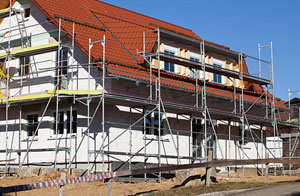
Local UK scaffolders should be happy to help you with residential scaffolding, rolling scaffolds, H-frame scaffolding in the UK, single scaffolds in the UK, confined space scaffolding in the UK, scaffold designs, access scaffolding, patented scaffolds in the UK, affordable scaffolding in the UK, system scaffolds, scaffolding companies, suspended scaffolds in the UK, tube and fitting scaffolds in the UK, goods and passenger hoists, 1-man scaffold towers, scaffolding quotations in the UK, the hire of scaffold boards in the UK, scaffolding contractors, bespoke scaffolding in the UK, bricklayer's scaffolding in the UK, scaffold tower hire in the UK, tower bridge decks, scaffolding for loft conversions in the UK, shoring scaffolds in the UK, scaffolding for sale in the UK and similar scaffolding related services.
When you are attempting to find UK scaffolders, you may also be interested in roofers in the UK, repointing specialists in the UK, gutter cleaning in the UK, brick and stone cleaning in the UK, solar panel cleaning in the UK, bricklayers in the UK, skip hire in the UK, waste removal in the UK, solar panel installation in the UK, loft conversions in the UK or painters and decorators in the UK.
UK Scaffolding Services
- UK Cantilever Scaffolding
- UK Industrial Screening
- UK Scaffolding Construction
- UK Scaffolding Erectors
- UK Domestic Scaffolding
- UK Scaffolding Hire
- UK Scaffolding Companies
- UK Painting Platform Hire
- UK Scaffold Tower Hire
- UK Suspended Scaffolding
- UK Tube and Fitting Scaffolds
- UK Mobile Scaffolding
- UK Industrial Scaffolding
- UK Shoring Scaffolding
UK Scaffolding Links: Scaffolders, Scaffolding Suppliers, Residential Scaffolders, Residential Scaffolding, Scaffold Rental, Scaffolding Suppliers, Construction Scaffolds, Scaffolds, Scaffolding, Domestic Scaffolding, Residential Scaffolding, Cheap Scaffolders, Scaffolding, Scaffold Hire, Residential Scaffolders, Cheap Scaffolders, Scaffolds and Shoring, Scaffolding Suppliers, Scaffolding Suppliers, Residential Scaffolding, Scaffolds and Shoring, Scaffolding, Construction Scaffolds, Scaffolding Firms, Scaffolding Firms, Construction Scaffolds, Scaffold Hire, Scaffold Companies, Scaffold Companies, Commercial Scaffolding, Scaffolding Contractors, Scaffolding Suppliers, Domestic Scaffolding, Shoring Scaffolds, Residential Scaffolders, Scaffold Hire, Scaffold Hire, Scaffold Specialists, Scaffolding Specialists, Scaffolds, Scaffold Hire, Scaffolding Suppliers, Construction Scaffolding, Scaffold Hire, Scaffolding Suppliers, Scaffolding Hire, Scaffolding Suppliers, Scaffolding Services, Residential Scaffolders, Scaffolds, Scaffolds, Scaffold Companies, Residential Scaffolding, Scaffolding Solutions, Scaffold Hire, Scaffolders, Scaffolds, Scaffolding Suppliers, Residential Scaffolders, Scaffolding Hire, Scaffolding Contractors, Scaffolding Suppliers, Residential Scaffolding, Construction Scaffolds, Scaffolding, Scaffold Specialists, Construction Scaffolding, Shoring Scaffolds.



